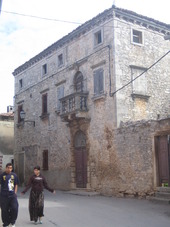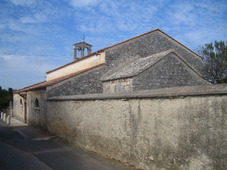to enlarge


or choose the place
from the menu below
 Rome |
 Byzantium |
 Venice |
 Vienna |
 Brioni |
 Smrikve |
 |
 |
There are few interesting old Baroque palaces that you will note easy and the first old building you will see is located in the first street that turns left after the small square if you arrive from the place where the big kazun was located. It is the Church of St. Anthony from the 10th century.
 On the main street towards the Parish Church you will note also one of the most attractive
Galizana’s palaces: the Giocondo Petris palace from 1676. You will recognize it for its Boroque balcony
on its main façade.
On the main street towards the Parish Church you will note also one of the most attractive
Galizana’s palaces: the Giocondo Petris palace from 1676. You will recognize it for its Boroque balcony
on its main façade.
The 36 meters high bell tower of the Parish Church dates back in the 17th century, while the Parish Church of St. Rock was built in 1613. Following the main road for other 30 meters you will arrive nearby the Church of St. Joseph that dates back into the 5th century.
Another interesting building is located in the first street that turns left after the Church of St. Joseph.
 This quite large building is the Church of St. Justus that was made
in the 9th century and later on restructured and expanded in the 14th century.
This quite large building is the Church of St. Justus that was made
in the 9th century and later on restructured and expanded in the 14th century.
To reach the last historical building you need to turn back to the main road where the church of St. Joseph is located and follow the main road for another fifty meters, than you have to take the road that goes right and cross the railroad. After the railroad continue to follow the road that goes left and you will arrive nearby another old Church “La Concetta” from the 12th century.
GALIZANA – HISTORICAL OVERVIEW
Galizana is another very old Istrian settlement. It is likely that was inhabited since prehistoric times. All the southern part of Istria was urbanized by Romans and divided into areas “saltus”, “centuriae” and “sors”.
The village Galizana developed in a “sors” that probably belonged to a Roman military commander of “gens Gallia”. The latin name of the village was Gallicianum that during the Middle Ages, in 1150, changed in Balisanum and later on in Golisani. In 1303 was named Calisanum.
The village is mentioned for the first time in 990. It is likely that Galizana was a feud of Pula’s Bishops already in the 9th century. In 1199 Galizana was given in feud to Ruggero Morosini that was also at the time Podesta’ of Pula. From 1300 the village was part of the Aquileia Patriarchs dominions in Istria.
Later on Galizana followed the destiny of Pula and Vodnjan being part of the Venice Republic.
After the fall of Venice in 1797, Galizana was part of the Austrian Empire and for a short period of time was under Napoleon domination. After the First World War and fall of the Austro-Hungarian Monarchy, Galizana, was part of Italy. After the Second World War became part of Yugoslavia (Croatia).
During the Italian Fascist period in Istria many Istrian families suffered from the regime or had to leave Istria. Fascism in Istria applied various repressive measures mostly towards Slav populations and this created the Antifascist Movement.
The Second World War was a very painful experience for the Istrian population and many innocent Istrians, both Slav and Latin, died during that war.
After the second World War Galizana became part of Yugoslavia (Croatia). There were three agreements between Yugoslavia and Italy which established that Istria would become a part of Yugoslavia: Paris Agreement of 1947, London Memorandum of 1954 and the Osimo Agreement reached in 1975.
In the first decade after the Second World War many Istrians, especially those living in towns and villages that for centuries were part of the Venice Republic, decided to leave Istria.
Galizana and Vodnjan are among the very few villages in southern Istria that maintained the Istro-Venetian dialect and Italian language.
In 1991 with the fall of Yugoslavia and the founding of the Republic of Croatia, the internal republic boundaries were recognised as the state boundaries and Galizana is today part of Croatia.
In 2013 Galizana became part of the European Union. You can not change the past but you can try to learn from it. The main aim of the European Union founders was to build a system that could avoid future wars and future refugees in Europe as I explain in COSMOPOLITE.